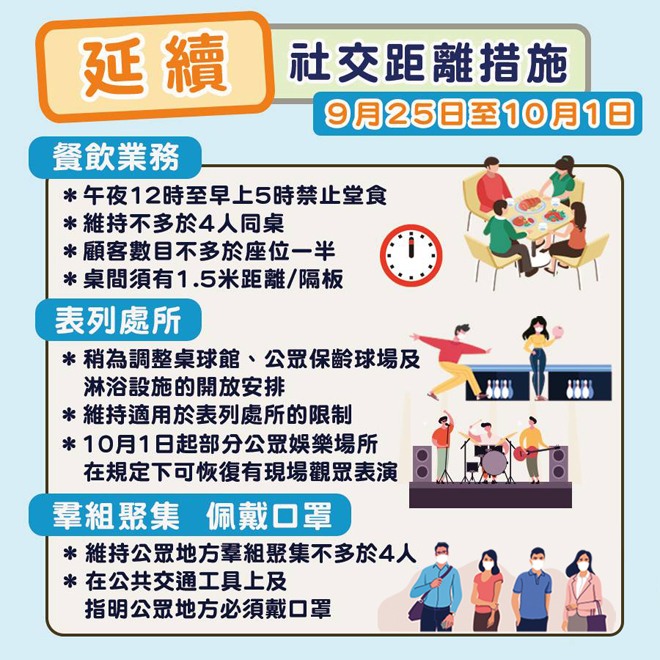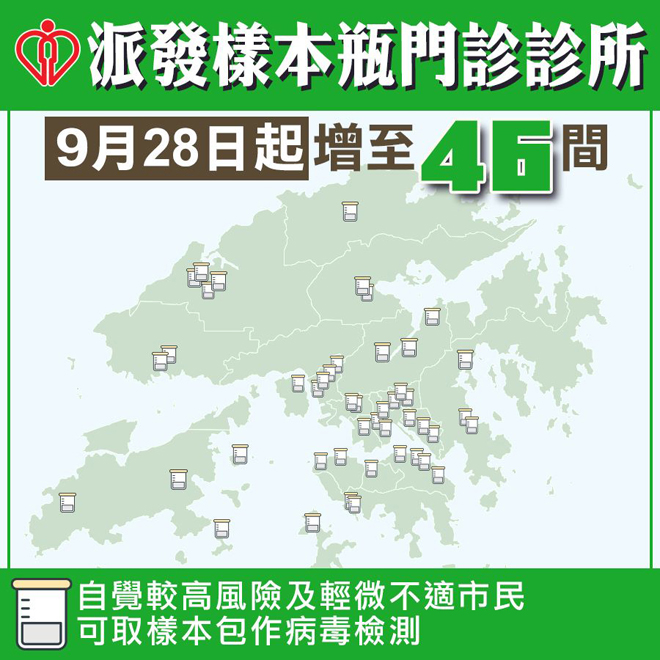Revision to the Police General Orders will not compromise press freedom
Fully prepared to fight next wave of epidemic
27 September 2020
Press freedom in Hong Kong, as enshrined in Article 27 of the Basic Law, is much valued by the HKSAR Government. It is not only our core value but also one of the major strengths of Hong Kong as an international cosmopolitan city.
The definition of "media representatives" under the Police General Orders (PGO) has recently been revised to allow frontline officers to identify bona fide reporters more effectively. This is to prevent people from using news reporting as a pretext to mingle in the crowd with the intent of obstructing the police and impeding law enforcement. The Police may then allow, where practicable, media representatives into a designated press area within a cordoned zone where media access is usually denied. Under the revised PGO, reporters may continue to cover news freely in public places as before.
I wish to emphasise that the revision has no bearing on lawful media reporting, while the Police will become more effective in discharging its duties to maintain law and order and ensure public safety.
In fact, the Police will make due arrangements for media reporting so long as operational efficiency is not compromised, and has maintained communication with the media to improve the arrangements. For the sake of media facilitation, the Media Liaison Team has increased its staffing to over 300 so as to provide adequate on-site support to the media during major public events.
According to the revised PGO, "media representatives" refer to reporters, photographers and television crews who are in possession of proof of identity issued by media agencies registered under the Government News and Media Information System (GNMIS), or by internationally recognised and reputable non-local news agencies, newspapers, magazines, radio and television broadcasters.
The GNMIS currently has a total of 206 subscribers, including a wide scope of local and international media, of which over 30 are internet-based.
The current-term HKSAR Government has all along attached great importance to press freedom and maintained close communication with the media. One prominent example is that the Government reviewed the arrangements for news coverage by online media soon after the commencement of its current term, and allowed eligible internet-based media to cover government press conferences and media events since September 19, 2017.
I would like to reiterate that the press freedom upheld by Hong Kong is well protected by the Basic Law, and will not be weakened or compromised by the revision.
Looking forward to an early implementation of the third round of relief measures
Two days ago (September 25), I attended a meeting of the Finance Committee of the Legislative Council with a number of Directors of Bureaux and colleagues to secure funding support for the third-round Anti-epidemic Fund and other related measures totalling around $24 billion. The meeting will continue tomorrow and I look forward to the early approval of the funding so that the Government can press ahead with implementing various measures to further enhance our anti-epidemic capability and provide assistance to sectors and individuals hard hit by the outbreak and the anti-epidemic measures.

|

|
Calling for co-operation and self-discipline from the public
With the third-wave of the epidemic subsiding noticeably, the social distancing measures currently in place are being relaxed in a gradual and orderly manner and extended to October 1. However, as the flow of people is resuming, some people have begun to let down their guard. For example, some food establishments have skipped body temperature checks, some have failed to comply with the seating capacity requirement, while some people, including foreign domestic helpers, have violated the prohibition on group gatherings of over four persons.
Since the orderly relaxation of social distancing measures from August 28, the Government has been stepping up patrols and prosecutions and carrying out inter-departmental joint operations to ensure that managers of premises and members of the public abide by relevant regulations. Altogether 46 000 and 2 500 inspections have been carried out this month on catering premises and various scheduled premises respectively with 123 and 96 prosecutions initiated against non-compliance.
On prohibition of group gatherings, enforcement departments have conducted a total of about 60 000 inspections this month in public areas on premises under their purview, with over 1 000 fixed penalty tickets issued to persons who participated in prohibited group gatherings and 17 prosecutions initiated against persons who organised or allowed such gatherings.
Co-operation and self-discipline are the best guards against the epidemic. Please be considerate and strictly comply with the relevant legislation. With the approach of the long holidays for National Day and Mid-Autumn Festival, members of the public are reminded to take anti-epidemic measures, avoid crowding and continue to maintain personal and environmental hygiene while celebrating the festive occasions.
The Government will continue to keep a close eye on the development of the epidemic and carefully assess the risks associated, making the best effort to strike a balance in the three-way tug of war among economic impact, community receptiveness and public health. We will strive for early implementation of the health code system to facilitate boundary crossing between Guangdong, Macao and Hong Kong, thereby enabling Hong Kong to start anew. The epidemic may remain stable for some time, but it is very likely that there will be another wave of outbreak this coming winter. As such, the Government is seizing time for extensive preparations to ensure prompt response to any future outbreak.
Two-pronged strategy for vaccine procurement
To safeguard public health, the Government adopts a "two-pronged" strategy to procure vaccines that meet the criteria of safety, efficacy and quality for the local population. On the one hand, we have joined the COVAX Facility to procure vaccines that will cover 35% of our population as a form of "safety net" to cater for the most vulnerable in society. On the other hand, we will, with regard to scientific evidence and clinical data and in consultation with relevant scientific committees under the Department of Health, enter into Advance Purchase Agreements (APAs) with individual vaccine developers to secure additional supplies. With the procurement of at least two candidate vaccines from different vaccine developers across different vaccine platforms under the APAs, we aim to procure sufficient doses of vaccines to cover at least twice our population so as to ensure that even if not all our chosen candidate vaccines under the APAs emerge as viable, territory-wide coverage can still be achieved.
Providing additional quarantine and isolation facilities
The provision of additional quarantine and isolation facilities plays a vital role in the containment of the epidemic. Apart from Blocks 1 to 3 of Chun Yeung Estate, which will cease to be used as a quarantine centre in due course, there are three quarantine centres operating at the moment, namely the Junior Police Call Permanent Activity Centre at Pat Heung, Sai Kung Outdoor Recreation Centre, and Penny's Bay Quarantine Centre Phase I.
Upon the return of Chun Yeung Estate for restoration, the Government will endeavour to ensure sufficient quarantine facilities by providing 700 units at the soon-to-be-completed Penny's Bay Quarantine Centre Phase 2, reactivating the use of Lei Yue Mun Park and Holiday Village in Chai Wan as quarantine centre, and leasing the entire block of hotels to accommodate close contacts. These three measures will offer a total of about 1 500 units, offsetting the shortfall arising from returning Blocks 1 to 3 of Chun Yeung Estate.
As for Penny's Bay Quarantine Centre Phases 3 and 4, some 2 000 new units will come into operation at year end, adding up to an estimated total of over 4 000 quarantine units by the end of 2020.
In parallel with the above efforts, the Government has assisted the Hospital Authority (HA) in setting up community treatment facilities, including the provision of 900 beds at AsiaWorld-Expo (AWE). With the staunch support of the Central Authorities, we will further expand the community treatment facility at AWE with almost 1 000 additional beds, and construct a two-storey temporary hospital nearby. With a site area of about 3 hectares, this temporary hospital will have negative pressure wards accommodating over 800 beds that is tailored to the needs of our residents and compliant with our laws and regulations. The construction of the community treatment facilities and the temporary hospital will be completed in around 4 weeks' and 4 months' time respectively.
Enhancing virus testing capacity and facilities
Our COVID-19 testing capacity has been enhanced significantly in the past two months. To broaden surveillance at the community level, and incorporate disease prevention and infection control into the new normal of the daily operation of society, the Government will integrate and regularise the Targeted Group Testing Scheme1.
The total number of HA's general out-patient clinics distributing specimen collection packs will be increased to 46 starting tomorrow (September 28). Meanwhile, the Government will gear up for urgent testing for targeted districts or groups in case of an outbreak in the community.
Given the volatility of the epidemic in Hong Kong and around the world, we are in a race against time to step up our prevention and control measures. Underestimating one's enemy can be fatal, and the same is true for this anti-epidemic battle. While the Government will stay alert and vigilant, members of the public should continue to comply with the anti-epidemic measures. Together we will win through and be able to revive our economy.
1 Based on risk assessment and depending on anti-epidemic needs, the Government will arrange testing on a regular basis or by random sampling for certain targeted groups, including (1) high-risk groups such as staff of residential care homes for the elderly, residential care homes for persons with disabilities and nursing homes; (2) high-exposure groups such as public transport drivers (including taxi drivers), frontline staff of catering businesses, stall operators and personnel working in markets; and (3) staff of critical infrastructure and services, such as slaughterhouse workers and designated frontline container terminal employees.

